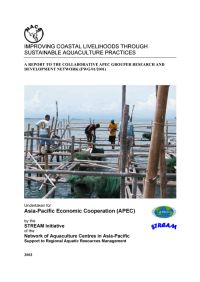Mariculture as a sustainable livelihood strategy in support of conservation and management - a case study of Komodo National Park, Indonesia
3 February 2004 | Lida Pet-Soede | 1674 Downloads | .pdf | 273.89 KB | Genetics and Biodiversity, Indonesia, Livelihoods, gender and social issues, Marine finfish
Together with the Indonesian Park Authority (PHKA), The Nature Conservancy has been working in Komodo National Park since 1995 to establish a marine reserve that 1) ensures long-term protection of the natural community structure, habitat and species of the coastal and marine ecosystems within and around Komodo National Park, and 2) protects a portion of the exploited reef fish stock to enhance fisheries in the traditional use zones inside the Park and in the waters surrounding the Park. This would protect and safeguard the marine biodiversity in the Park as a source of recruits for surrounding fishing grounds. One of the facilitating approaches to minimise pressure on the reef and demersal resources of KNP is the alternative livelihood program. Since 1997, TNC and PHKA conducted studies and developed facilities in support of production of grouper fingerlings. The aim is to provide these fingerlings to local communities for grow-out to marketable size. This project was created for two important reasons: to provide sustainable fish culture as an alternative to non-sustainable fishing practices in and around KNP, and to transform part of the Indo-Pacific capture-based (unsustainable) grouper fishery into a culture-based (sustainable) grouper trade. The other mariculture project component comprises seaweed culture. Furthermore, TNC/PHKA implements alternative livelihood projects in eco-tourism and offshore fisheries. These other projects are not discussed here.
Key characteristics of the fish mariculture project in KNP are the context of Marine Protected Area management and the full-cycle operation, which includes a local hatchery for fingerling production. Technical difficulties that have occurred along the way include collecting a healthy brood stock and providing sufficient food of good quality to maintain health. Furthermore, other difficulties were experienced in guiding the perception that these activities were initiated in support of KNP management, rather than for enrichment of some selected business entrepreneurs. Continued education and enhanced awareness of these issues have increased local understanding of the mariculture project, which is now instrumental in building an increasing constituency for management of KNP.
This case study aims to illustrate that mariculture activities could contribute greatly to conservation purposes and more sustainable use of natural resources. Thus mariculture can play an important role responding to dwindling natural fish stocks, through generating alternative incomes rather than through generating alternative sources of protein. When embedded in a comprehensive and integrated Marine Protected Area strategy, such as is the case in Komodo National Park, mariculture can greatly enhance local understanding and support for the need to protect certain parts of the marine and coastal environment to prevent further and imminent collapse of fisheries and related coastal communities’ livelihoods. This point should be carried forward and put in the right policy and institutional context as a highly beneficiary impact of mariculture.
More attention should be directed to share the lessons learned within this context to educate policy-makers. The perception needs to shift from viewing mariculture as an opportunity to produce more fish, towards viewing it as an opportunity to support livelihoods, integrated with comprehensive Marine Protected Area management. Thus, mariculture, when designed to allow for low ecological impact and maximum community involvement and benefits, can contribute to turning the tide of dwindling stocks and collapsing community livelihoods.
Copyright, all rights reserved.

